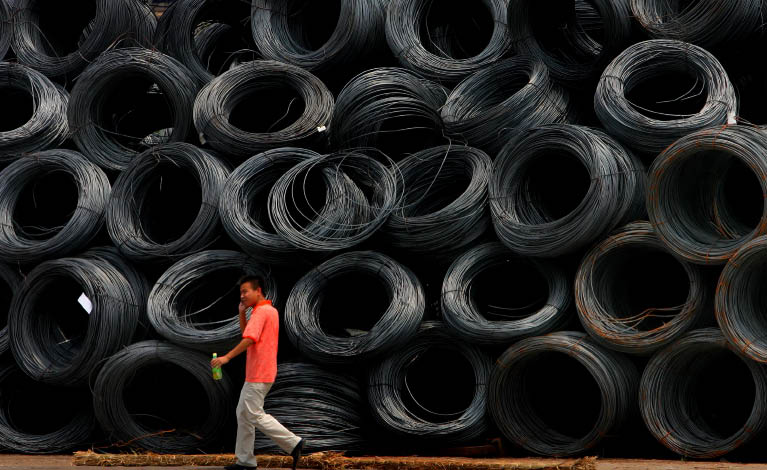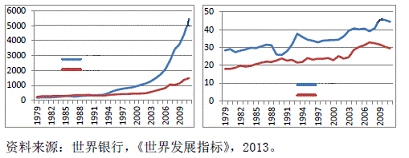Investment, Consumption and the Current Economic Situation
By JUSTIN YIFU LIN
CURRENTLY, “consumption-driven growth” is overwhelmingly popular in China’s economic circle, while the term “investment” is becoming a negative one. Even worse, some online commentators are citing “investment” as the cause of every problem in the Chinese economy. In spite of this trend, I am with the minority still placing importance on investment.
In fact, this consumption chorus was already taking shape prior to the outbreak of the global financial crisis in 2008. At that time, a number of Chinese and foreign scholars believed that over-saving, over-investment and insufficient consumption had resulted in an imbalance of international payment, thus threatening the global economy. They suggested that China shift its economic growth mode to a consumption-driven one while reducing saving, investment and trade surplus.
By 2008 when the global financial crisis took hold, China introduced a RMB 4 trillion stimulus package as a macro-control measure, most of which was used in infrastructure building. This huge investment saved the country from large-scale unemployment while enabling it to maintain rapid growth despite the unfavorable external situation. However, as in foreign countries, there are also many Chinese economists who are critical of the government’s counter-cyclical measures. They suggest that China rely on the market to play its role of adjustment, and take this opportunity to change its mode of economic growth. Since 2011, economic growth in China has slowed, which serves to justify the critique and suspicion, domestic and overseas, of the investment-driven mode and its sustainability.
A good doctor should prescribe treatment according to the patient’s symptoms. The very cause of imbalance of international payment is America’s over-consumption rather than over-saving and over-investment in China. I have expounded these views clearly in my book From Western Trend to East Wind – My Interpretation of Significant Economic Issues During My Four-Year Employment at the World Bank. This book was published in June 2012 after I retired from the post of senior vice president of the World Bank. But I would like to add more evidence here as reference. The trade surplus accounted for 7.6 percent of China’s GDP in 2007 and it dropped to 2.8 percent in 2012. What’s worth noting is that this period saw no decrease in investment, but, on the contrary, an increase from 41.6 percent of China’s GDP in 2007 to 48.1 percent in 2012. It also saw a slight reduction of consumption, which dropped from 49.6 percent in 2007 to 49.2 percent in 2012. Therefore, it is apparent that the huge imbalance of international payment was by no means caused by “over-saving and over-consumption” in China.
China’s economic growth has been losing momentum since the first quarter of 2011, marking an appalling decline in the 30-odd years of reform and opening-up. But, the situation in other emerging economies is even worse. For example, economic growth in Brazil dropped to 2.7 percent in 2011 and 0.9 percent in 2012 from 7.5 percent in 2010, while that of India dropped to 7.0 percent in 2011 and 5.3 percent in 2012 from 9.0 percent in 2010. Investment has accounted for less than 20 percent of Brazil’s GDP for a long time, while the percentage in India is around 30 percent. This clearly proves that it is wrong to say China’s investment-driven mode of economic growth is unsustainable and that it is the very cause of the economic slowdown.
Why were the two groups of emerging economy – those adopting the investment-driven growth mode and those adopting the consumption-driven mode simultaneously suffering the same slowdown? I believe there are two reasons. First, the economy in Europe entered a double-dip period of recession. Though the U.S. economy recovered slightly, it only recorded a growth of 2.2 percent last year. According to the World Bank forecast it will come to 2.0 percent this year, far lower than the seven or eight percent growth in the previous period of economic recovery. Continuous economic weakening of developed countries resulted in a sharp decline in exports from the emerging economies. Secondly, the counter-cyclical stimulus projects that started in 2008 have been completed or are near completion. Thus, the demand for investment domestically has decreased. Therefore, it is not reasonable to blame the investment-driven mode for the economic slowdown, which was actually a natural result of periodical factors.
It is true that investment has accounted for a higher percentage of China’s national economy for a long time, while consumption has dropped to 50 percent or less of China’s GDP from about two thirds 30 years ago. However, should we come to the conclusion that this is a problem? China is still a developing country. The past 33 years of reform and opening-up have seen rapid development. But the main goal remains keeping the economy stable, progressing swiftly, and sustainable, thus eventually narrowing the income gap with the developed countries. In fact, heavy investment in a country’s economy has bearing on the performance of the country’s economic growth. According to Michael Spence, recipient of the 2001 Nobel Prize in Economic Sciences, and leader of the Commission on Growth and Development, since World War II, there are 13 economies in the world that have maintained economic growth of seven percent or higher for 25 years or longer. There are five characteristics that these 13 economies share, and that of high saving and high investment is one of them.
|
 |
| The demand for iron and steel remains strong this year amid China’s stable economic growth. |
Among the East Asian economies that boast miraculous economic growth is Singapore, number one in per-capita income. Calculated according to purchasing power parity, the per-capita income in Singapore was as high as US $60,688 in 2011, 26 percent higher than that of the United States which was US $48,112. The per-capita income of Japan was US $33,668 in 2011, just 55 percent of that of Singapore. For many years, Singapore has maintained a high saving rate, which accounts for around 50 percent of its GDP. Japan is different. In 1990, before its economic bubble burst, its saving rate was 34 percent, but dropped to 22 percent in 2011. What’s worth noting is that the increase of consumption percentage did not help the country to turn a corner after suffering from 20-odd years of economic slowdown. That may be the reason why one of the major components of “Abe economics” is to increase government investment in order to drive economic growth.
The major goal of economic development is to improve people’s consumption and living standards. Increasing consumption may contribute to economic growth in the short term. However, the real driving force of sustained economic growth is investment rather than consumption because continuous increase in consumption should have a precondition, namely, an increase in income. Higher incomes depend on constant improvement of labor productivity. Improvement of the level of labor productivity is usually a result of technical innovation and industrial upgrading, both of which rely heavily on investment. Sustained economic growth also relies on improved infrastructure, a must for decreasing the cost of transactions and removing the bottleneck to economic growth. Without investment, technical innovation, industrial upgrading and constant improvement of infrastructure are impossible. Without improvement of labor productivity, talk of increasing consumption is nothing but hot air. If a country continued to increase consumption in spite of the overall condition of these factors, it would run into debt. If it kept borrowing more and more and could not stop, it would lose its debt-servicing capacity and eventually fall into crisis. This is exactly what happened in the United States and southern Europe in recent years. Conversely, investment in technical innovation, industrial upgrading and infrastructure would result in an improvement of labor productivity and economic efficiency, which would eventually increase income. In the latter phase of this cycle, investment and consumption would increase simultaneously. The fact is that during the period 2008 to 2012, China’s annual increase of consumption was 9.2 percent, while that in the period from 1978 to 2007 was 7.7 percent. This shows that the period during which China was experiencing domestic and overseas criticism for investment-led growth also happened to be the period witnessing the fastest growth in consumption.
A good example of the importance of investment to sustainable economic growth is a comparison of the development of China and India. Both are ancient civilizations and both have huge populations amounting to over one billion. The two countries share similar experiences in overcoming colonial or semi-colonial control after World War II, and have endeavored to modernize ever since. Calculated according to the value of the US dollar in 1979 when China inaugurated its new policy of reform and opening-up, the per-capita income in India was US $227.6 and that of China US $182.3, lower by 20 percent. But in 2011, the per-capita income of India was just US $1,458.5, while that of China rose to US $5,420.6, 3.7 fold that of India. The sharp contrast in development bears relevance to the two countries’ investment rate. It shows that the proportion of China’s fixed asset in its GDP had been 10 percentage-points higher than India for a significant amount of time. What should be considered is the fact that recent years saw a sharp increase in India’s growth rate and a proportional increase of fixed asset forming in its GDP, which rose from 25 percent or lower to 30 percent or higher after 2005.
|
 |
| Source: World Bank WDI, World Bank, 2013 |
As a developing country experiencing a transitional period, China has structural problems of its own. China adopted a “dual-track approach” to gradually push forward the transition from a planned to a market economy. It helped China avoid the economic meltdown and extended stagnation seen in the former Soviet and eastern European countries due to the so-called “shock therapy.” But, the negative heritage of the “dual-track approach” was “distortions” and “interventions,” both sources of deterioration of income distribution, rampant rent-seeking and corruption. Indeed, China has to unswervingly deepen its reform and opening-up to eradiccate these evils at root and eventually build a modern and market-oriented economy.
It is true that poor investment practices also exist in China, such as wave phenomenon, excess production capacity and low-level production overlap. However, it is also wrong to blame investment for the problems in China’s national economy apparent in the decrease in residents’ incomes, over-issuing of currency, lack of innovation, pollution and corruption. Those who suggest that China give up the investment-driven mode of economic growth and change to the consumption-driven mode are essentially “throwing out the baby with the bathwater.”
Given the staggering global economy and downward pressure of the domestic economy, private investment needs to be encouraged to stimulate consumption to keep economic growth stable. As a developing country, China can still provide vast opportunities for investment in technical innovation, industrial upgrading, infrastructure (especially inner city infrastructure) and environmental improvement. These projects are investments with high economic and social returns that may help initiate consumption, solve over-capacity, boost economic growth, and increase employment and income. After all these projects are completed, they will contribute to improving productivity, growth quality and economic performance. Therefore, advocating these investments is actually a good measure of benefit to both the present and the future.

